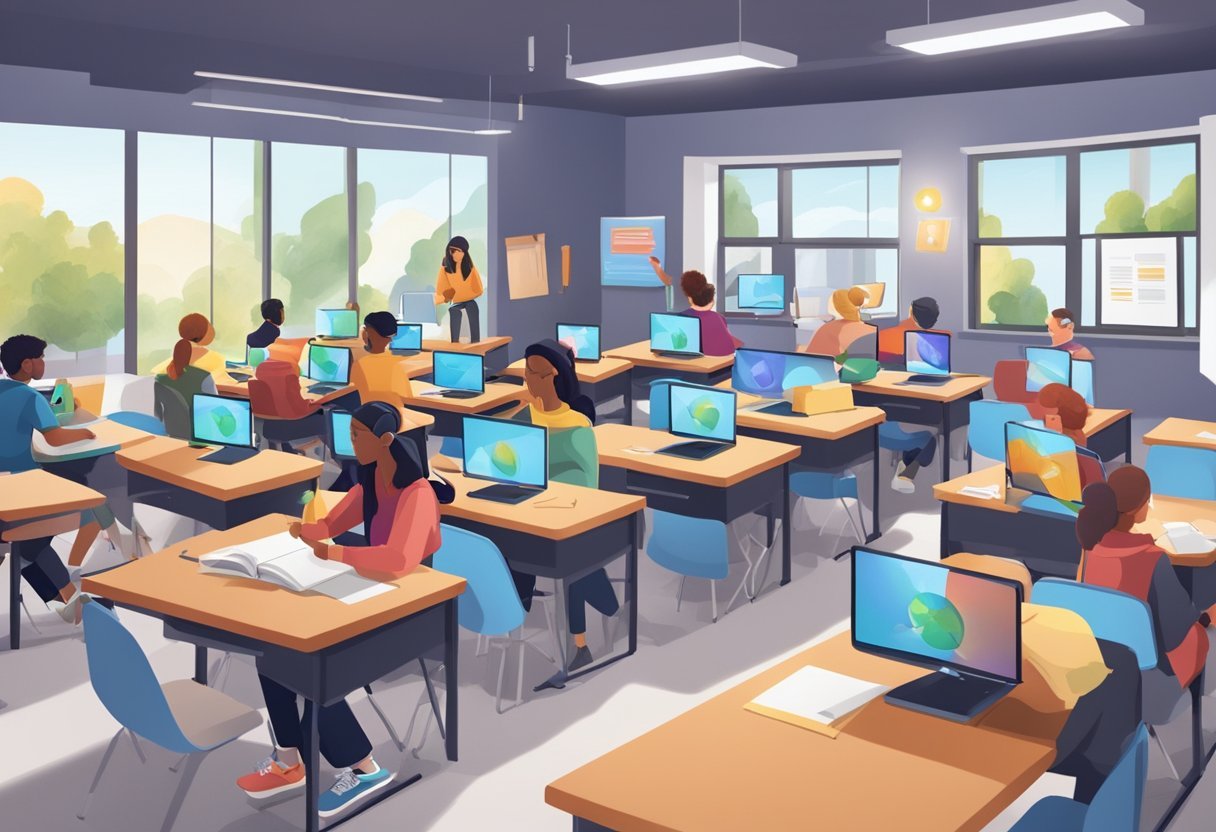Augmented reality (AR) is a technology that allows digital information to be overlaid onto the real world. In education, AR can enhance learning by providing an interactive and immersive experience for students. By using AR, students can visualize complex concepts, explore virtual environments, and interact with digital objects. In this blog post, we will discuss what is augmented reality in education, how AR works in education and the benfits for students and educators
Fundamentally, AR in education is about creating a more engaging and interactive learning experience. AR can be used in a variety of ways, from bringing historical events to life to visualizing complex mathematical equations. It can also be used to create interactive textbooks, allowing students to explore and interact with content in a more engaging way.
Key Takeaways
- Augmented reality in education enhances learning by providing an interactive and immersive experience for students.
- AR can be used to visualize complex concepts, explore virtual environments, and interact with digital objects.
- AR has the potential to revolutionize the way we teach and learn by creating a more engaging and interactive learning experience.
What is Augmented Reality in Education
Augmented Reality (AR) is a technology that overlays digital information such as sounds, videos, and graphics on top of the real-world environment. In education, AR is used to enhance the learning experience by providing interactive and engaging content to students. AR is often confused with Virtual Reality (VR), a technology that creates entirely artificial environments. Unlike VR, AR does not require a completely artificial environment, but it overlays digital information onto the real-world environment.
How does AR work in Education
AR works by using a display system, such as a computer or mobile device, to overlay digital information onto the real-world environment. This digital information is created using computer graphics and is designed to be interactive and engaging for students. AR systems use a variety of sensors, such as cameras and GPS, to track the user’s location and orientation in the real-world environment. This information is used to align the digital information with the real-world environment, creating a seamless and immersive learning experience.
AR in education provides a new way to deliver educational content to students. By using AR, students can interact with content in a more engaging and interactive way. AR can be used to provide visualizations of complex concepts, such as scientific models or historical events. AR can also be used to provide real-world examples of abstract concepts, such as mathematical equations or physics principles. AR can be used in a variety of educational settings, from classroom lectures to field trips and museum visits.
AR has the potential to revolutionize the way we teach and learn. By providing interactive and engaging content, AR can help students better understand and retain information. AR can also provide personalized learning experiences, allowing students to learn at their own pace and in their own way. As AR technology continues to improve, we can expect to see even more innovative and exciting uses for AR in education.
Implementing AR in the Classroom
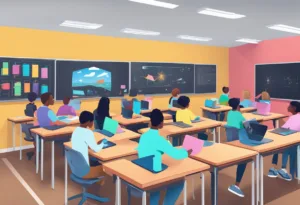
Augmented reality has the potential to revolutionize the way students learn in the classroom. By providing interactive and immersive experiences, AR can help students better understand complex concepts and engage with the material in a more meaningful way. Here are some key considerations when implementing AR in the classroom.
Interactive Learning Environments
AR can create interactive learning environments that allow students to explore and engage with the material in a more hands-on way. For example, an AR app can allow students to explore a virtual anatomy model and interact with it in ways that wouldn’t be possible with a traditional textbook. This can help students better understand the material and retain it more effectively.
Educational AR Applications
There are many educational AR applications available that can be used in the classroom. These apps cover a wide range of subjects, from science and math to history and literature. Some popular AR apps for education include Anatomy 4D, World Brush, and Elements 4D.
Hardware and Software Requirements
Implementing AR in the classroom requires the right hardware and software. To use AR apps, students will need a mobile device such as a tablet or smartphone. Some AR apps may require additional hardware such as a headset or stylus. It’s important to ensure that all students have access to the necessary hardware and software to fully participate in AR activities.
Implementing AR in the classroom can provide students with a more engaging and immersive learning experience. By creating interactive learning environments and using educational AR applications, students can better understand complex concepts and retain information more effectively. However, it’s important to ensure that all students have access to the necessary hardware and software to fully participate in AR activities.
Curriculum Integration and Content Development
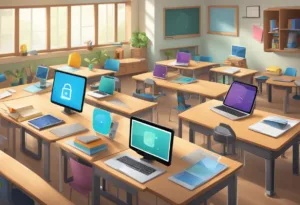
Augmented Reality (AR) technology has the potential to revolutionize the way students learn by providing them with an immersive and interactive learning experience. Integrating AR technology into the curriculum can help students understand complex concepts in a more engaging and meaningful way.
AR in STEM Education
AR technology can be used to teach various subjects in the STEM field, including chemistry, geometry, and engineering. For example, AR simulations can be used to show students how molecules interact with each other in chemistry. In geometry, AR technology can be used to create 3D models of complex shapes and structures, making it easier for students to visualize and understand them. AR technology can also be used to teach engineering concepts, such as how machines work or how to design and build structures.
Enhancing Creative Arts and Humanities
AR technology can also be used to enhance creative arts and humanities education. For example, AR can be used to create virtual tours of historical sites, allowing students to experience history in a more immersive and interactive way. AR can also be used to create 3D models of art and architecture, allowing students to explore and interact with them in a more engaging way. AR technology can be used to enhance language learning by creating interactive and immersive language learning experiences.
When it comes to content development, it is important to create high-quality and engaging AR content that is focused on education rather than entertainment. This can be achieved by working with subject matter experts to ensure that the content is accurate and relevant to the curriculum. AR content should also be designed to be interactive and engaging, with features such as quizzes, games, and simulations that encourage active learning.
Integrating AR technology into the curriculum can help students learn in a more engaging and meaningful way. With the right content and curriculum integration, AR technology has the potential to transform the way students learn and understand complex concepts.
Benefits of AR in Education
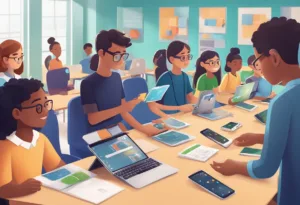
Augmented Reality (AR) technology has numerous benefits in education. Here are five benefits of AR in education:
1. Increased Student Engagement
AR technology enables students to interact with digital elements in the real world, making learning more engaging and interesting. The use of AR in education can help students to visualize and understand complex concepts, making the learning process more enjoyable.
2. Improved Collaboration
AR technology allows students to work together on projects and assignments, which can help improve collaboration skills. By using AR technology, students can create shared experiences and learn from each other’s perspectives.
3. Enhanced Assessments
AR technology can be used to create interactive assessments that provide immediate feedback to students. This can help educators to identify areas where students need additional support and adjust their teaching methods accordingly.
4. Personalized Learning
AR technology can be used to create personalized learning experiences for students. By tailoring the learning experience to individual students’ needs, educators can help ensure that all students receive the support they need to succeed.
5. Real-World Applications
AR technology can help students to see how the concepts they are learning apply in the real world. By using AR to create simulations and other interactive experiences, educators can help students to understand how the knowledge they are gaining can be used in practical applications.
Incorporating AR technology in education can help improve the overall learning experience for students. It can increase engagement, improve collaboration, enhance assessments, enable personalized learning, and provide real-world applications.
Disadvantages of Augmented Reality in Education
While augmented reality (AR) has many potential benefits in education, there are also some disadvantages to consider. Here are five key drawbacks to using AR in the classroom:
- Cost: One of the main disadvantages of AR in education is the cost. AR technology can be expensive, and not all schools may have the budget to invest in it. There may be ongoing costs for maintenance and updates.
- Technical Issues: Another potential drawback of AR in education is technical issues. AR relies on technology, and technical glitches or malfunctions can disrupt the learning process. This can be frustrating for both students and teachers.
- Limited Content: While AR can provide an immersive learning experience, the content available may be limited. Not all subjects may have AR content available, and the quality of the content may vary.
- Distraction: AR can be engaging and exciting, but it can also be a distraction. Students may become so focused on the AR content that they lose sight of the learning objectives.
- Accessibility: Finally, AR may not be accessible to all students. Students with certain disabilities or impairments may not be able to fully participate in AR activities. Not all students may have access to the necessary technology to use AR.
It is important to weigh these disadvantages against the potential benefits of AR in education when deciding whether or not to incorporate AR into your classroom.
Case Studies and Practical Applications
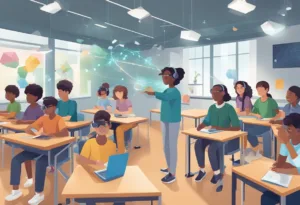
Real-World Examples in Education
There are numerous real-world examples of augmented reality in education. One such example is the use of AR in anatomy classes, where students can use AR apps to visualize and interact with 3D models of the human body. This provides a more immersive and engaging learning experience for students, allowing them to better understand the complexities of the human body.
Another example is the use of AR in language classes, where students can use AR apps to practice their language skills in a more interactive and engaging way. For instance, students can use AR apps to scan real-world objects and receive translations or definitions in real-time.
Usability Evaluations and Research
Usability evaluations and research are crucial in the development of educational augmented reality applications. By conducting usability evaluations and research, developers can ensure that their applications are intuitive, easy to use, and effective in enhancing learning outcomes.
For example, a study conducted by Chan et al. (2022) compared the learning outcomes of students using VR to those using other methodologies such as augmented reality and hands-on learning. The study found that VR was more effective in enhancing learning outcomes in certain areas, such as spatial reasoning and problem-solving.
Innovation is also key in the development of educational augmented reality applications. For instance, a study by Huang et al. (2019) explored the integration of VR and AR in different areas and directions, highlighting the potential for innovative uses of these technologies in education. Case studies and practical applications of augmented reality in education demonstrate the potential for these technologies to enhance learning outcomes and provide more engaging and interactive learning experiences for students.
Frequently Asked Questions
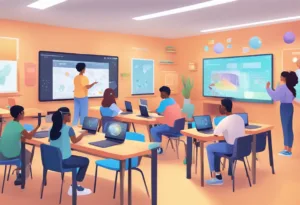
What does AR mean in education?
AR stands for Augmented Reality, which is a technology that overlays digital information like videos, sounds, and graphics on top of the real-world environment. In education, AR is used to enhance the learning process by providing students with an interactive and immersive experience.
How is augmented reality used in education?
AR is used in education to create interactive and engaging learning experiences that can help students understand complex concepts. For example, AR can be used to create 3D models of objects that students can interact with, or to provide additional information about a subject by overlaying digital information on top of a physical object.
What is augmented reality in simple words?
Augmented Reality, or AR, is a technology that overlays digital information on top of the real-world environment. This technology can be used to create interactive and engaging learning experiences that can help students understand complex concepts.
How does augmented reality affect students learning?
AR can have a positive impact on student learning by providing an interactive and immersive experience that can help students understand complex concepts. By using AR, students can interact with digital objects in the real world, which can help them better understand the subject matter.
What is an example of augmented reality in the classroom?
One example of AR in the classroom is using AR to create 3D models of objects that students can interact with. For example, an AR app can be used to create a 3D model of the solar system that students can interact with, allowing them to explore the planets and learn about their characteristics.
What are the disadvantages of augmented reality in education?
One disadvantage of AR in education is that it can be expensive to implement. Some students may find the technology distracting or difficult to use, which can negatively impact their learning experience. It is important to carefully consider the benefits and drawbacks of using AR in education before implementing it in the classroom.

